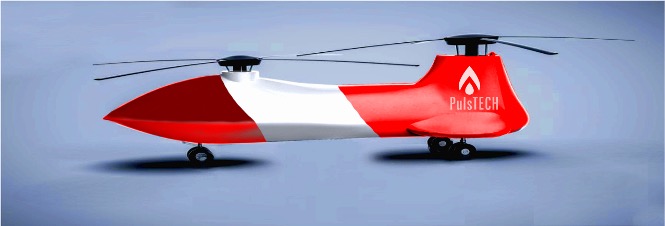MULTIPURPOSE HEAVY-DUTY DRONE
- Requirements:
- Payload Capacity: Minimum 300 kg
- Maximum Takeoff Mass: 600 kg
- Flight Duration: 300 minutes per tanking
- Engine Power Output: 200 hp
- Cruising Speed: 120 km/h
- Vertical Takeoff and Landing: Yes
- Stability: Great stability, low turbulence sensitivity
- Multifunctional: Flexible connectivity with a wide range of platforms and auxiliary systems in both civilian and military applications.
- Suitability for Emergency Situations: Adequate stability and safety class for rescue, medivac, and other emergency personnel transport.
- Standardized Production Cost
Unfortunately, none of the currently available drones worldwide fully meet these specifications.
PulsTECH is developing its specialized multipurpose drone that fulfills all the aforementioned conditions. The development is undertaken by a team of experts in the field, including experienced aircraft designers and builders. A preliminary design for the drone has been completed, forming the basis for the preparation of 3D engineering and production drawings.

To ensure the utmost flexibility and simplicity in the operation and maintenance of the drone, standard, mass-produced components are utilized as much as possible. This includes the engine, reducers, clutches, rotor blades, and other parts, as well as the control system hardware and software.
The time required to manufacture a flying prototype (subject to funding availability) is estimated at 18 months.
WHY A DRONE WITH THESE SPECIFICATIONS?
While there are thousands of drones with various designs, a drone specifically for forest firefighting requires extended flight duration, payload capacity, and vertical takeoff and landing capabilities for covering large distances. Such drones are scarce, if not entirely nonexistent.
For covering significant distances, a gasoline-powered drone is most suitable, as it can conduct 50-100 missions per day, extinguishing fires from 5-10 km away. In contrast, an electric-powered drone can only manage two missions with a single charge. Given that the battery cost comprises nearly half of the drone’s total cost, it is prudent to favor a gasoline-powered drone.
A drone with the above specifications is not only suitable for firefighting but also serves various purposes in both civilian and military sectors. This standardized and generic drone, composed of key components, is easy and cost-effective to operate, repair, modify, and quickly adapt for different applications. Essentially, it represents a new, flexible drone platform.

Comments are closed.